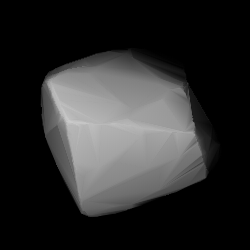astro.wikisort.org - Asteroid
361 Bononia /bəˈnoʊniə/ is a very large, resonant Hilda asteroid located in the outermost region of the asteroid belt.[2] It is classified as a D-type asteroid and is probably composed of organic rich silicates, carbon and anhydrous silicates. It was discovered by Auguste Charlois on 11 March 1893, in Nice, and assigned the prov. designations A893 EF and 1893 P.
 Modelled shape of Bononia from its lightcurve | |
| Discovery | |
|---|---|
| Discovered by | Auguste Charlois |
| Discovery date | 11 March 1893 |
| Designations | |
MPC designation | (361) Bononia |
| Pronunciation | /bəˈnoʊniə/[1] |
Named after | Bologna (Bonōnia) |
Alternative designations | 1893 P |
Minor planet category | Main belt (Hilda) |
| Adjectives | Bononian |
| Orbital characteristics[2] | |
| Epoch 31 July 2016 (JD 2457600.5) | |
| Uncertainty parameter 0 | |
| Observation arc | 114.83 yr (41940 d) |
| Aphelion | 4.80719 AU (719.145 Gm) |
| Perihelion | 3.11281 AU (465.670 Gm) |
Semi-major axis | 3.96000 AU (592.408 Gm) |
| Eccentricity | 0.21394 |
Orbital period (sidereal) | 7.88 yr (2878.3 d) |
Mean anomaly | 329.195° |
Mean motion | 0° 7m 30.259s / day |
| Inclination | 12.6264° |
Longitude of ascending node | 18.8738° |
Argument of perihelion | 68.3637° |
| Physical characteristics | |
| Dimensions | 141.72±6.9 km |
Synodic rotation period | 13.83 h (0.576 d) |
Geometric albedo | 0.0453±0.005 |
Spectral type | D |
Absolute magnitude (H) | 8.22 |
References
- "Bononia". Merriam-Webster Dictionary.
- "361 Bononia (1893 P)". JPL Small-Body Database. NASA/Jet Propulsion Laboratory. Retrieved 11 May 2016.
External links
- 361 Bononia at AstDyS-2, Asteroids—Dynamic Site
- 361 Bononia at the JPL Small-Body Database
На других языках
[de] (361) Bononia
(361) Bononia ist ein Asteroid des Hauptgürtels, der am 11. März 1893 von Auguste Charlois in Nizza entdeckt wurde.- [en] 361 Bononia
[es] (361) Bononia
(361) Bononia es un asteroide perteneciente al cinturón exterior de asteroides descubierto el 11 de marzo de 1893 por Auguste Honoré Charlois desde el observatorio de Niza, Francia. Está nombrado por Bolonia, una ciudad italiana.[2][ru] (361) Бонония
(361) Бонония (лат. Bononia) — крупный астероид внешней части главного пояса, принадлежащий к астероидам спектрального класса D. Его поверхность богата силикатами и простейшими углеродными соединениями, чем обусловлено его довольно низкое альбедо. Астероид был открыт 11 марта 1893 года французским астрономом Огюстом Шарлуа в обсерватории Ниццы и назван в честь латинского названия итальянского города Болонья или французского города Булонь-сюр-Мер[1].Текст в блоке "Читать" взят с сайта "Википедия" и доступен по лицензии Creative Commons Attribution-ShareAlike; в отдельных случаях могут действовать дополнительные условия.
Другой контент может иметь иную лицензию. Перед использованием материалов сайта WikiSort.org внимательно изучите правила лицензирования конкретных элементов наполнения сайта.
Другой контент может иметь иную лицензию. Перед использованием материалов сайта WikiSort.org внимательно изучите правила лицензирования конкретных элементов наполнения сайта.
2019-2025
WikiSort.org - проект по пересортировке и дополнению контента Википедии
WikiSort.org - проект по пересортировке и дополнению контента Википедии